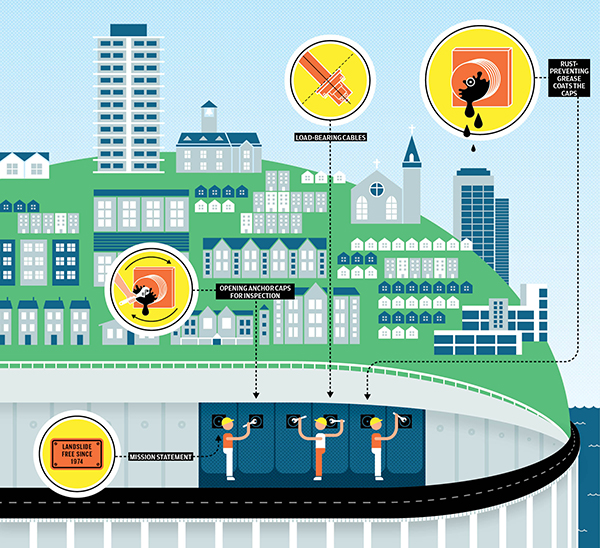There’s a subterranean drip, the trickle and splash of groundwater. Here and there delicate stalactites cling to the curved walls. Cutting like an artery nine feet in diameter, a tunnel rests between Oregon Street and I-471’s northbound exit ramps, 100 feet below ground. At the earth’s surface, cars zip past a nondescript white knob of a building just large enough to house an elevator shaft. Ralph Schuler waits up top, hoping he won’t be needed. It’s his job to manually override and call for help if the elevator gets stuck. It’s happened before.
In the tunnel below is one end of an anchorage system that straps a 1,175-foot-long retaining wall, and in turn, Mt. Adams, in place. In 1973 construction of I-471 nipped the toe of Mt. Adams, triggering a landslide that cracked foundations and destroyed 16 homes. As part of a $22 million project, the lower flanks were reinforced in the early ’80s with an earthen buttress and retaining wall consisting of hay-colored cylinder piles that can be seen from the highway. Twenty-four of the towering piles are drilled permanently into bedrock. But over 100 are tethered to anchors in the below-ground tunnel, with bunches of approximately 200 steel wire tendons running in between. Each bunch bears loads of up to 800 tons.
While individual tendons work at a stress load equal to only about 60 percent of their ultimate strength, it’s not like Super Man’s unyielding single hair holding up a thousand pounds. Sometimes tendons fray or snap. Responsibility for bearing the load shifts to the rest of the unit. It’s a system with multiple back-ups, but it can’t be left untended.
So twice a year engineers from Palmer Engineering, contracted by the Ohio Department of Transportation, give the system a check-up, looking for cracks, checking for movement. There’s no remote monitoring inside the tunnel, but Bronson Funke, a civil engineer and project manager, notes that a team frequently inspects for aboveground movement: “There’s some value in going out in the field and seeing it in person. Seeing how the hillside is acting.”
After a week-and-a-half of careful interior measurements, snooping for fine fissures in the walls of the tunnel, and comparisons to the last round of monitoring, the dirty work begins.
There is a theme: grease and precision. Engineers unbolt anchor caps so coated in rust-preventing grease they resemble richly iced cakes. When the seal is broken, built-up groundwater and grease spray from the tunnel wall as seven or eight anchor caps are unscrewed and plugs are removed. Near cap number 76, written on the wall in grease is a warning: “CLOSE YOUR EYES.”
Then it’s a count of pin heads, ball-shaped nubs at the end of the wire tendons that are held in place by a locking mechanism. “We make sure none are snapping…if it snaps, or if it’s starting to snap, those pins will pop out, and we’ll be able to know,” says engineering technician Scott Walker. The process repeats above ground along the external retaining wall. It’s a snapshot of how a fraction of the supports are doing, and over time, engineers rotate through the entire system.
In a hilly city prone to slippage, wires and concrete piles hold up a mountain. In a constant battle with gravity, the mountain’s keepers do their counts. Again, they tighten the screws.
Illustration by Headcase
Originally published in the March 2014 issue.





Facebook Comments